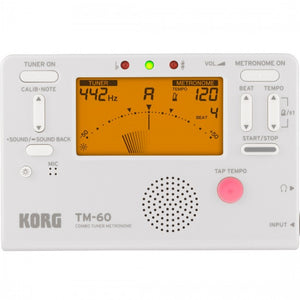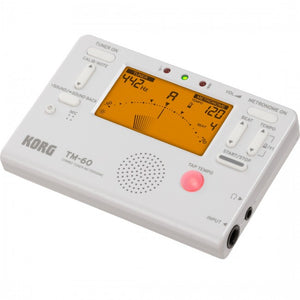Your Cart is Empty


Product Information:
The Korg TM-60WH is the newest model and features a larger display that can show the tuner and metronome simultaneously. The battery life has also been dramatically improved. With the all-new TM-60, you’ll be able to enjoy pitch training and rhythm training without having to switch functions or be concerned with battery life.
The TM-60, the tuner/metronome that’s even more convenient and easier to use.
Tuning and rhythm training are indispensable for brass band or orchestral practice. In addition to letting you use the tuner and metronome simultaneously, the TM-60 features a display that’s approximately 1.3 times larger than the previous model (the TM-50), allowing easy viewing even when the unit is placed on your music stand, and also allowing the tuner and metronome functions to both be viewed simultaneously.
No longer will you have to switch between functions; you’ll be able to use practicing techniques that are idiomatic to orchestral instruments, such as keeping a consistent pitch over the course of a long note while varying the tone to add vibrato in time with the tempo, or checking the pitch of chords while using the metronome.
The enlarged display is backlit. You can adjust the brightness in two levels, soft or auto, ensuring stress-free tuning even when you’re on a dimly lit stage or in an orchestra pit.
The circuitry has been redesigned to achieve a battery life of 130 hours, approximately double that of the previous TM-50 model (tuner in use, backlight off). There’s no need to worry about the remaining battery life even during extended practices or performances.
Specifications:
- Equipped with high-precision tuner function and metronome function. The two functions can be used simultaneously.
- The display is approximately 1.3 times the size of the previous model (TM-50), allowing the tuner and metronome to be shown simultaneously.
- Backlit LCD ensures excellent visibility even in dark locations.
- LCD needle-type meter detects the pitch instantly, providing the excellent response that you expect from KORG.
- A wide detection range of C1–C8 supports a broad range of instruments.
- Calibration is adjustable to match various concert pitches.
- Marks are provided to indicate pure major and minor third intervals.
- Sound Out mode and Sound Back mode are great ways to train your ear.
- Metronome features a wide tempo range from 30 to 252 beats/minute. Choose from three types of tempo settings and 15 rhythm variations.
- Long-life design with approximately double the battery life. (Compared to the KORG TM-50, in tuner mode with backlight off)
- Convenient memory backup function and auto power-off function.
- Further improvements in ease of use, including a newly designed stand and battery compartment cover.
- Available in black or white, two simple and timeless colors.
- Separately sold CM-200 contact mic allows even higher tuning precision. The lineup also includes the TM-60C which is packaged with a CM-200 in a color that matches the body of the tuner/metronome unit.
Scale: 12 note equal temperament
Detection Range: C1 (32.70 Hz) ~ C8 (4186 Hz), Using Sine Wave.
Reference Tone: C3 (130.81 Hz) ~ C6 (1046.50Hz), 3 Octave.
Tuning Modes: Meter Mode (AUTO), Sound Out Mode (MANUAL), Sound Back Mode (AUTO)
Detection Accuracy: +/- 1 cent
Sound Accuracy: +/-1 cent
Tempo Range: Quarter Note = 30 to 252 BPM
Tempo Setting: 3 Types:Pendulum Step, Full Step, Tap Tempo
Terminals: Input (6.3mm, Mono-Standard Jack type), Headphones (3.5mm, Stereo-mini Jack type)
Internal Speaker: Dynamic Speaker (23 mm)
Power Supply: AAA battery (3.0 V) x 2
Battery Life:
Tuner: Approximately 130/55/36 hours (backlight: off/soft/auto, continuous A4 input, using zinc-carbon batteries)
Metronome: Approximately 130/55/36 hours (backlight: off/soft/auto, tempo 120, 4 beats, maximum volume, using zinc-carbon batteries)
Dimensions: (W x D x H) 111 x 74 x 18 mm
Weight: 100 g (Including battery)
Warranty
1 Year (Extended to 3 Years via Registration) WarrantyShipping & Delivery
All orders over $100 will be automatically eligible for FREE Shipping Australia Wide, if you order is under $100 there will be a flat rate of $10.
Belfield Music is well known for its top online customer service. We treat all online customers with the same excellent service we give to our in store customer. We will ensure that you receive all the support you need while your goods are in transit and ensure the goods arrive promptly. All of our shipments have tracking numbers available and we cover every single unit by our own shipping insurance.
Online orders are normally processed within 1-3 business days. Once processed, your order should take between 1-8 business days to arrive depending on your location. Please note that your order may take up to 10 business days to arrive from the day you place your order.
If it transpires that the product is out of stock due to a stock discrepancy and/or there will be a delay in shipment, we will contact you within 2 business days of placing your order and give you the option of waiting or cancelling your order. The products we advertise online should show if they are in stock or not. We do our best to keep the website stock count up to date, but there may be an occasional error.
If you wish to utilize an Express Delivery Service to receive your item, please contact us for a shipping quote before you place your order at admin@belfieldmusic.com.au or by using the Chat icon on the bottom right of the page.
Deliver is made during the hours from 8:00am till 5:30pm Monday to Friday. As such, please ensure you nominate an address which is capable of receiving goods during 8am and 5.30pm. Given the restrictions on PO Box deliveries we cannot deliver larger sized items to a PO Box.
If for any reason our selected carriers don't service your area we will contact you before processing your order if this applys to you.
Returns Policy
If you wish to return an item which is not damaged or faulty in any way and you have simply changed your mind or made the wrong decision, you must let us know within 7 days of receiving the item. We will not agree to refund an item because you simply changed your mind or made the wrong decision if we have not been advised of your intention within 7 days of receiving your item. Once we have provided a return authority, it is the buyer’s responsibility to return the item, at their own costs within 30 days from original purchase. If the item is returned with any damage or alteration to its original packaging, we will refund the item subject to applying a minimum 15% restocking fee. We will not refund the costs of the initial shipping charges.
It is in Belfield Music best interests to keep our customers happy with their purchases. If you are not happy with your purchase, please talk to us first. We will always attempt to resolve any problems you may have as best we can. To contact us please email us at admin@belfieldmusic.com.au or by using the Chat icon on the bottom right of the page.









